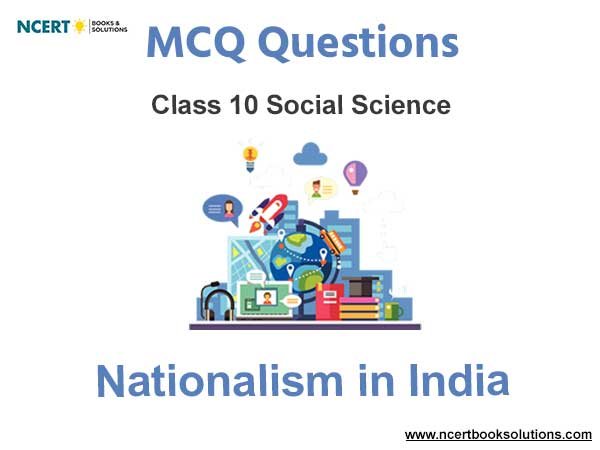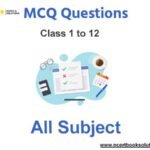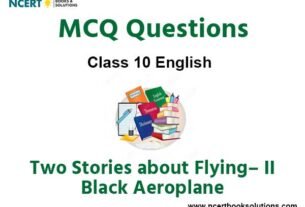Please refer to the MCQ Questions for Class 10 Social Science Chapter 2 Nationalism in India with Answers. The following Nationalism in India Class 10 Social Science MCQ Questions have been designed based on the current academic year syllabus and examination guidelines for Class 10. Our faculty has designed MCQ Questions for Class 10 Social Science with Answers for all chapters as per your NCERT Class 10 Social Science book.
Nationalism in India Class 10 MCQ Questions with Answers
Please see below Nationalism in India Class 10 Social Science MCQ Questions, solve the questions and compare your answers with the solutions provided below.
Question. Under the presidency of Jawahahar Lai Nehru, the Lahore Congress Session of 1929 formalised the demand of
(a) abolition of Salt Tax
(b) ‘Puma Swaraj’ or complete independence
(c) boycott of Simon Commission
(d) separate electorate for the ‘dalits’
Answer
B
Question. Which party did not boycott the Council elections held in the year 1921?
(a) Swaraj Party
(b) Justice Party
(c) Muslim League
(d) Congress Party
Answer
B
Question. Arrange the following historical events in a chronological sequence
I. Rowlatt Act
II. Kheda Satyagraha
III. Champaran Movement
IV. Ahmedabad Mill Strike
Choose the Correct option:
(a) I, II, III, IV
(b) II, I, III, IV
(c) III, I, IV, II
(d) III, II, IV, I
Answer
D
Question. Baba Ramchandra, a sanyasi, was the leader of which of the following movements?
(a) Khilafat Movement
(b) Militant Guerrilla Movement of Andhra Pradesh
(c) Peasants’ Movement of Awadh
(d) Plantation Workers’ Movement in Assam
Answer
C
Question. Why did General Dyer order to open fire on a i peaceful demonstration at Jallianwala Bagh? Choose from the given options.
(a) He wanted to show his power.
(b) Firing was ordered because it was an unruly crowd.
(c) Because his object, as he declared later, was to ‘produce a moral effect’ to create fear in the minds of ‘satyagrahis’.
(d) He ordered to fire because he noticed a j sudden unrest in the crowd.
Answer
C
Question. The Non-cooperation Khilafat Movement began in
(a) January 1921
(b) February 1922
(c) December 1929
(d) April 1919
Answer
A
Question. Who was the first writer to create the image of ‘Bharat Mata’ as an identity of India and how?
(a) Bankim Chandra Chattopadhyay in 1870, by writing the song “Vande Mataram” and later including it in his novel ‘Anand Math’
(b) Rabindranath Tagore through his collection of ballads, nursery rhymes and myth
(c) Mahatma Gandhiji during his salt march and satyagraha.
(d) Ravi Verma
Answer
A
Question. Who formed the ‘Swaraj Party’ within the Congress?
(a) Jawahar Lai Nehru and Motilal Nehru
(b) Abdul Ghaffar Khan and Mahatma Gandhi
(c) Jawahar Lai Nehru and Subhas Chandra Bose
(d) C.R. Das and Motilal Nehru
Answer
D
Question. Certain events are given below. Choose the appropriate chronological order:
I. Coming of Simon Commission to India
II. Demand of Purna Swaraj in Lahore Session of INC
III. Government of India Act 1919
IV. Champaran Satyagraha
(a) i—iv—iii—ii
(b) iv—iii—i—ii
(c) iv—i—ii-iii
(d) iii—iv—ii—i
Answer
B
Question. Who founded the ‘Depressed Classes Association’ in 1930?
(a) Alluri Sitaram Raju
(b) C.R. Das
(c) M.R. Jayakar
(d) Dr B.R. Ambedkar
Answer
D
Question. The Swaraj Party was formed by
(a) C.R. Das and Motilal Nehru.
(b) Motilal Nehru and M.A. Jinnah.
(c) M.K. Gandhi and C.R. Das.
(d) Motilal Nehru and Radha Krishnan.
Answer
A
Question. Abdul Ghaffar Khan was a devout disciple of
(a) Gopal Krishan Gokhale.
(b) Feroz Shah Mehta.
(c) Mahatma Gandhi.
(d) Motilal Nehru.
Answer
C
Question. The Congress Socialist Party was formed in the year
(a) 1928.
(b) 1934.
(c) 1920.
(d) 1940.
Answer
A
Question. The imposition of Martial law by the British was done in the year 1919 in
(a) Amritsar
(b) Chandigarh.
(c) Patna.
(d) Kanpur.
Answer
A
Question. The “Harijan” was a term used by Gandhiji to address the Dalits and it meant
(a) local children.
(b) powerful children.
(c) children of God.
(d) native children.
Answer
C
Question. Match the following terms with proper meanings and choose the answer from the codes given below:
| Column I | Column II |
| (a) Khilafat | i. All India Trade Union Congress |
| (b) Oppressors | ii. turned out |
| (c) evicted | iii. Tyrannical rulers |
| (d) AITUC | iv. Opposition, defiance |
(a) A-iv; B-iii; C-ii; D-i
(b) A-ii; B-iii; C-iv; D-i
(c) A-ii; B-iii; C-iv; D-i
(d) A-iii; B-iv; C-ii; D-i
Answer
A
Question. Gandhi’s idea of Satyagraha emphasised the power of truth and the need to search for
(a) atma.
(b) god.
(c) spirit.
(d) truth.
Answer
D
Question. During the Non-Cooperation Movement, Jawaharlal Nehru began going around the villages in Awadh in
(a) June 1920.
(b) June 1921.
(c) June 922.
(d) June 1923.
Answer
A
Question. The object that was seen as a symbol of Western economic and cultural domination was
(a) foreign food
(b) foreign cloth.
(c) foreign spices.
(d) foreign shoes.
Answer
B
Question. In Madras, a massive four-volume collection of Tamil folk tales titled The Folklore of Southern India was published by
(a) Natesa Sastri
(b) Neelakanda Sastri
(c) Subramaniya Iyer
(d) Shanmugam Nambiar
Answer
A
Question. In 1930, the president of the All India Muslim League was
(a) Maulana Muhammad Ali.
(b) Muhammad Ali Jinnah.
(c) Sir Aga Khan.
(d) Sir Muhammad Iqbal.
Answer
D
Question. The book ‘Hind Swaraj’ was written by
(a) Ambedkar.
(b) Bal Gangadhar Tilak.
(c) Nathuram Godse.
(d) Mahatma Gandhiji.
Answer
D
Question. The national movement in India started spreading to new areas, incorporating new social groups after
(a) 1916.
(b) 1917.
(c) 1918.
(d) 1919.
Answer
D
Question. Labour that villagers were forced to contribute without any payment was known as
(a) adimai.
(b) begar.
(c) bethi.
(d) pannai.
Answer
B
Question. The personality who organised Dalits into the depressed classes association in 1930 was
(a) B.R. Ambedkar.
(b) M.K.Gandhi.
(c) Maulana Azad.
(d) Bal Gangadhar Tilak
Answer
A
Question. The Congress adopted the resolution for complete independence of India during the session of
(a) Calcutta
(b) Lahore
(c) Nagpur
(d) Surat
Answer
B
Question. The Poona Pact was signed in
(a) 1932.
(b) 1933.
(c) 1934.
(d) 1935.
Answer
A
Question. In 1917, Gandhi organised a Satyagraha to support the peasants of the Kheda district of
(a) Andhra Pradesh.
(b) Bihar.
(c) Gujarat.
(d) Rajasthan.
Answer
C
Question. The Dalits were ignored by the Congress for a long time for the fear of offending the upper caste Hindus called
(a) Sanatanis.
(b) Brahmins.
(c) Kshatriyas.
(d) Kayasthas.
Answer
A
Question. The commodity used by Gandhiji to relate the abstract idea of freedom to the more concrete issues of life was
(a) food.
(b) sugar.
(c) indigo.
(d) salt.
Answer
D
Question. Jallianwalla Bagh incident took place in
(a) Amritsar in Punjab.
(b) Faridkot in Punjab.
(c) Jalandhar in Punjab.
(d) Patiala in Punjab.
Answer
A
Question. Gandhiji visited Champaran in Bihar, to inspire the peasants to struggle against the oppressive
(a) english education.
(b) racial discrimination.
(c) plantation system.
(d) revenue collection.
Answer
C
Question. The meaning of the term ‘Boycott’ is
(a) cooperation.
(b) refusal and rejection.
(c) revolution.
(d) a war method.
Answer
B
Question. The organisers of the Khilafat Movement were
(a) Mahatma Gandhi and BG Tilak.
(b) Motilal Nehru and CR Das.
(c) Syed Ahmed Khan and Abdul Kalam Azad.
(d) Mohammad Ali and Shaukat Ali.
Answer
D
Question. Gandhi-Irwin Pact was signed on
(a) 5 March 1931
(b) 6 April 1931
(c) 7 May 1931
(d) 8 June 1931
Answer
A
Question. The idea of Satyagraha emphasised on the need and search for
(a) truth.
(b) love
(c) passion
(d) fear.
Answer
A
Question. The Congress had boycotted the
(a) First Round Table Conference
(b) Second Round Table Conference
(c) Third Round Table Conference
(d) First and Third Round Table Conference
Answer
A
Question. In 1930, protest rallies saw the participation of workers in thousands wearing Gandhi caps and belonging to the
(a) Chottanagpur tin mines.
(b) Assam coal mines.
(c) Kolapur gold mines.
(d) Rajasthan Limestone mines.
Answer
A
Question. When was “Salt March” started?
(a) January 31, 1930.
(b) February 2, 1930.
(c) March 12, 1930.
(d) April 6, 1930.
Answer
C
Question. The main objective of the Non-Cooperation Movement was
(a) achievement of Swaraj
(b) annullment of the Rowlatt Act 1919
(c) preventing dismemberment of Turkey
(d) undoing the injustices done to Punjab.
Answer
A
Question. What did the Rowlatt Act, 1919 presume?
(a) Detention of political prisoners without trial
(b) Forced recruitment in the army
(c) Forced manual labour
(d) Equal pay for equal work
Answer
A
Question. Who himself took interest to revive folklore in West Bengal?
(a) Rabindranath Tagore
(b) Bankim Chandra Chattpadhyay
(c) Abanindranath Tagore
(d) All of the above
Answer
A
Question. From which year, the National Movement spread to new areas incorporating new social groups and developing new modes of struggle?
(a) 1914
(b) 1916
(c) 1919
(d) 1918
Answer
C
Question. Who was the President of Muslim League in 1930?
(a) Sir Muhammad Iqbal
(b) Shaukat Ali
(c) Muhammad Ali Jinnah
(d) Maulana Azad
Answer
A
Question. This sense of collective belonging came partly through
(a) united struggles
(b) peace struggles
(c) individual struggles
(d) None of these
Answer
A
Question. In Which continent, modern nationalism came to be associated with the formation of nation-state?
(a) Australia
(b Europe
(c) North America
(d) Africa
Answer
B
Question. When was the Non-cooperation Khilafat Movement begin in India?
(a) January 1919
(b) January 1921
(c) February 1920
(d) February 1922
Answer
B
Question. What did the term ‘picket’ refer to?
(a) Stealing from shops
(b) Import of goods
(c) Protest by blocking shop entrances
(d) Boycott of clothes and goods
Answer
A
Question. What was not used as a new link which redefined the boundaries of communities and the making of the new national entity?
(a) New symbols
(b) New songs and ideas
(c) Icons
(d) Customs
Answer
D
Question. Federation of Indian Commerce and Industries was formed by:
(a) British traders
(b) Indian farmers
(c) Indian merchants
(d) None of the above
Answer
C
Question. In late 19th century India, which ideas was revived through a movement to develop nationalism?
(a) Figure or images
(b) Popular Prints
(c) History and fictions
(d) Folklore or songs
Answer
D
Question. Who headed the ‘Oudh Kisan Sabha’ In Awadh?
(a) Subhash Chandra Bose
(b) Madan Mohan Malviya
(c) Bipin Chadra Pal
(d) Jawaharlal Nehru
Answer
D
Question. The nation is most often symbolised in which of the forms?
(a) History and fiction
(b) Figures or images
(c) Popular prints
(d) Folklore or songs
Answer
B
Question. What created a new economic and political situation in India during 1913-1918?
(a) War
(b) Femine
(c) Peace
(d) Flood
Answer
A
Question. Which province did not boycott the council election?
(a) Madras
(b) Ahmedabad
(c) Hyderabad
(d) Lucknow
Answer
A
Question. In Awadh, peasants were led by which sanyasi who had earlier been to Fiji, as an indentured labourer?
(a) Baba Ramdev
(b) Baba Nagarjuna
(c) Baba Ramchandra
(d) Baba Parmanand
Answer
C
Question. Which class was mainly involved initially in Noncooperation Khilafat Movement?
(a) Elite class
(b) Lower class
(c) Middle class
(d) All of the above
Answer
C
Question. During the British India, how many provinces were there?
(a) Six
(b) Eight
(c) Seven
(d) Nine
Answer
B
Question. When did Mahatma Gandhi return to India?
(a) January 1912
(b) January 1914
(c) January 1913
(d) January 1915
Answer
D
Question. What was the effect of the Non-cooperation movement on the plantation workers in Assam?
(a) They left the plantations and headed home.
(b) They went on a strike.
(c) They destroyed the plantations.
(d) None of these
Answer
A
Question. Oudh Kisan Sabha was set up and headed by:
(a) Jawaharlal Nehru
(b) Mahatma Gandhi
(c) Bal Gangadhar Tilak
Answer
A
Question. What was the main problem with the Simon Commission?
(a) It was an all British commission.
(b) It was formed in Britain.
(c) It was set up in response to the nationalist movement.
(d) All of the above
Answer
A
Question. The Round Table Conferenc which was boycotted by he Congress.
(a) Second
(b) First
(c) Third
(d) None of the above
Answer
B
Question. A militant Guerrila movement spread in:
(a) Garo hills
(b) Khasi hills
(c) Gudem hills
(d) None of the above
Answer
C
Question. Where was Gandhi’s ashram located?
(a) Dandi
(b) Sabarmati
(c) Allahabad
(d) Nagpur
Answer
B
Question. With the growth of nationalism, who created the image of Bharat Mata in the 20th Century?
(a) Nand Lal Bose
(b) Abanindranath Tagore
(c) Rabindranath Tagore
(d) Bankim Chandra Chattopadhyay
Answer
D
FILL IN THE BLANKS
Question. The Word War had ended with the defeat of __________.
Answer
Ottoman Turkey
Question. __________ Claimed that he had a variety of special powers of healing and make astrological predictions.
Answer
Alluri Sitaram Raju
Question. Mahatma Gandhi believed that the __________ of non-violence could unite all Indians.
Answer
Dharma
Question. Under the Inland Emigration Act of __________, plantation workers were not permitted to leave the tea gardens without permission.
Answer
1859
Question. __________ cloth was often more expensive than mass produced mill cloth.
Answer
Khadi
TRUE / FALSE
Question. The Simon Commission arrived in India in 1928.
Answer
True
Question. Khan Abdul Ghaffar Khan was a disciple of Mahatma Gandhi.
Answer
True
Question. C.R. Dass and Jawaharlal Nehru formed the Swaraj Party.
Answer
False
Question. The industrial working classes participated in the civil disobedience movement, except the Nagpur.
Answer
False
Question. Gandhiji reached Dandi on 10 April 1930 to break the salt law.
Answer
False








